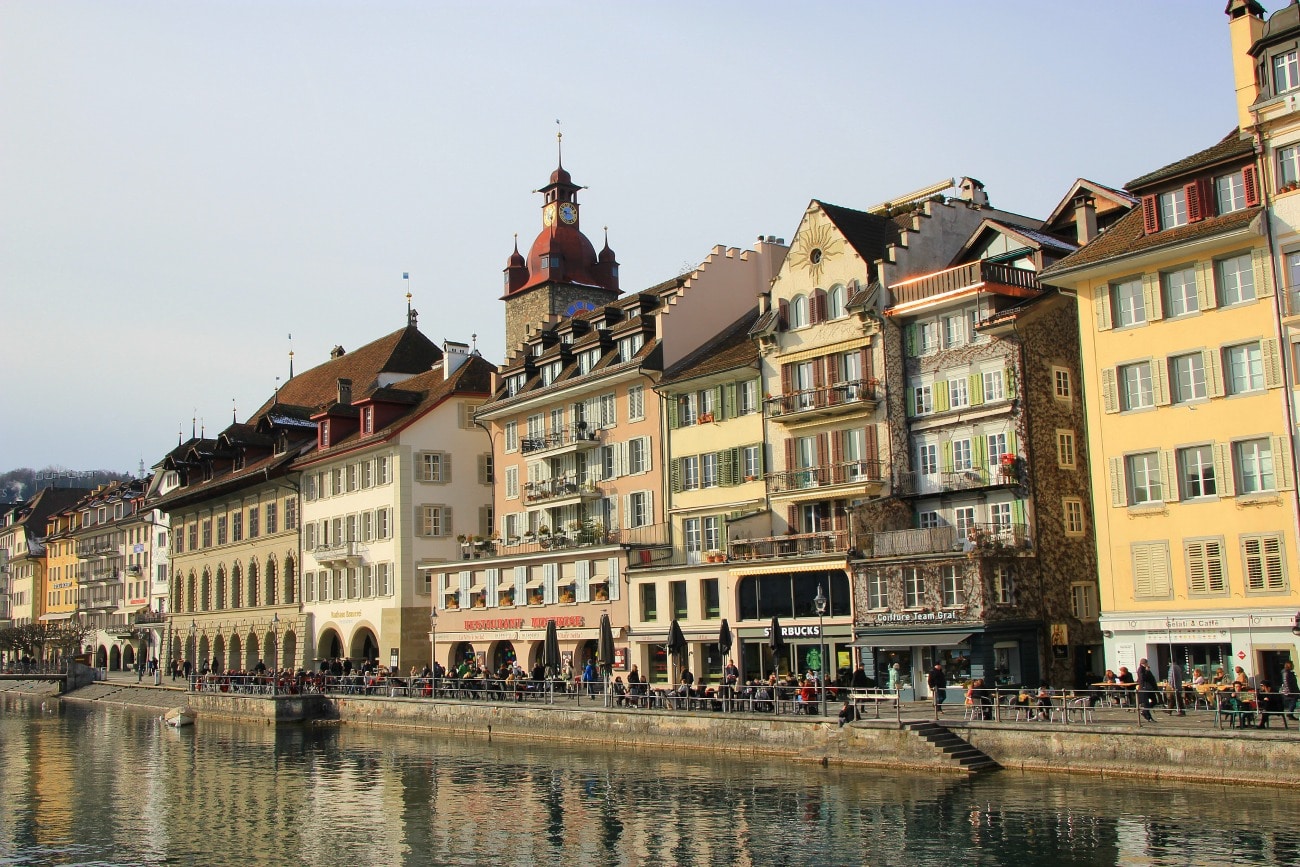Lucerne is often called “the City of Lights.” The name goes back to a miracle which is said to have happened here. According to a legend, an angel showed the first arriving settlers with a light where to build a chapel in honor of St. Nicholas, the patron saint of fishermen and sailors. Today, it still has amazing grace and for many travelers Lucerne, with its crystal-clear lake, snow-capped mountains and well-preserved medieval Altstadt (Old Town) is the embodiment of Switzerland.
A Haven for Travelers
The fascination with charming Lucerne is centuries old. The English painter William Turner made it famous with a series of watercolors in the 1830s and 40s, and in 1863, nearby Rigi mountain was the highlight of the world’s first overseas package holiday. Organized by Thomas Cook, a group tour to Switzerland included ascending the summit to watch the sunrise.
Lucerne got a further boost in popularity when Queen Victoria, mourning the loss of her husband, Prince Albert, and a small entourage headed to central Switzerland for a five-week getaway in 1868. The Alps provided the grieving monarch with healthy mountain air, while sightseeing tours, painting, and horseback riding refreshed her soul. Within two years of her stay, a Hotel Victoria had opened in Lucerne, there was a steamer bearing her name and today there are more than 20 Victoria hotels in Switzerland.
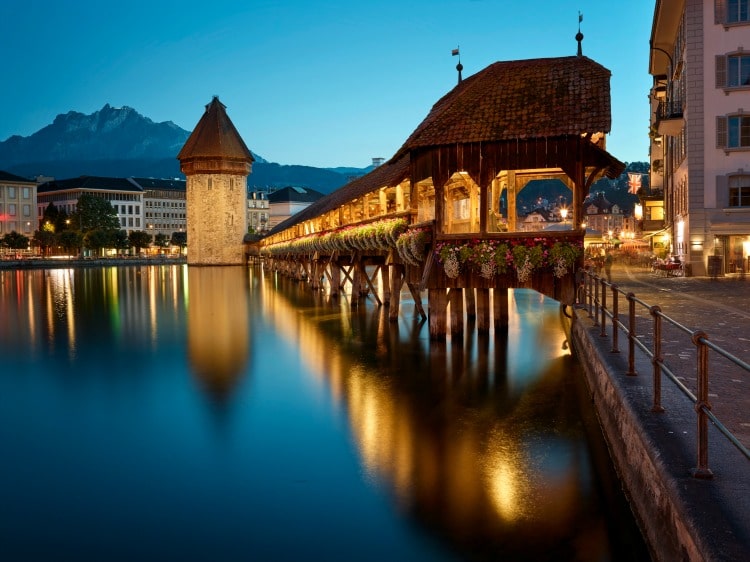
Historic Sites
Then as now, Lucerne’s major drawcard is the wooden Chapel Bridge, constructed in the first half of the 14th century. However, unlike Queen Victoria who enjoyed the original, today’s visitors cross the Reuss River on a replica. “Unfortunately, on a dry summer evening in August 1993, someone carelessly threw a lit cigarette butt away and all but the two bridgeheads burned down”, said the city guide, Rebecca Gisler. Also destroyed were 110 of the 17th-century paintings which adorned the bridge with two-thirds either going up in smoke or suffering severe damage.
Next to Chapel Bridge stands the second landmark of Lucerne, the octagonal water tower which used to be part of the city’s fortifications but was subsequently used as an archive, treasury, and prison. The ancient Musegg Wall has nine towers of which four are open to the public. The clock on the Zyt Tower is the town’s oldest and chimes the hours one minute before the others, perfectly fitting for a nation that hates to be late.
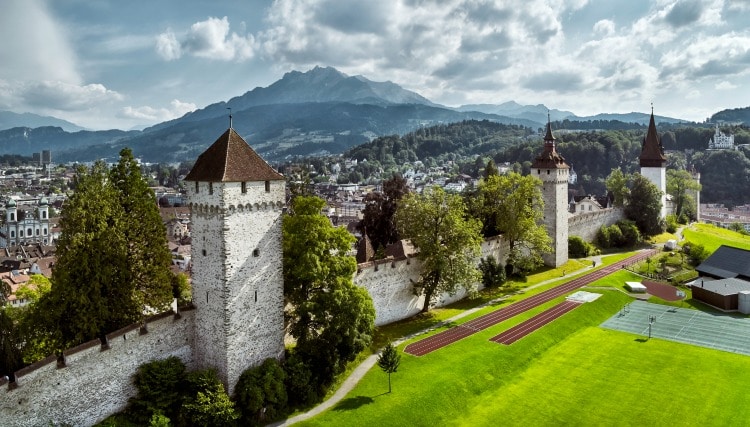
Precision Timepieces
There are thousands if not tens of thousands of timepieces ticking in Lucerne which makes it, together with Paris and Shanghai, a leading watch trading center. Many Chinese nationals (after Swiss and American travelers—the third largest visitor group in Lucerne) travel to the town with the aim of purchasing a genuine Swiss watch. The main shopping street, Hertensteinstrasse, is lined with high-end retail stores and Bucherer has, allegedly, the world’s largest selection of Rolex watches. “Lucerne is China’s #1 destination in Switzerland. They love the cultural diversity, cruises on the lake, the proximity to the mountains but also things we take for granted like fresh air,” commented Gisler.
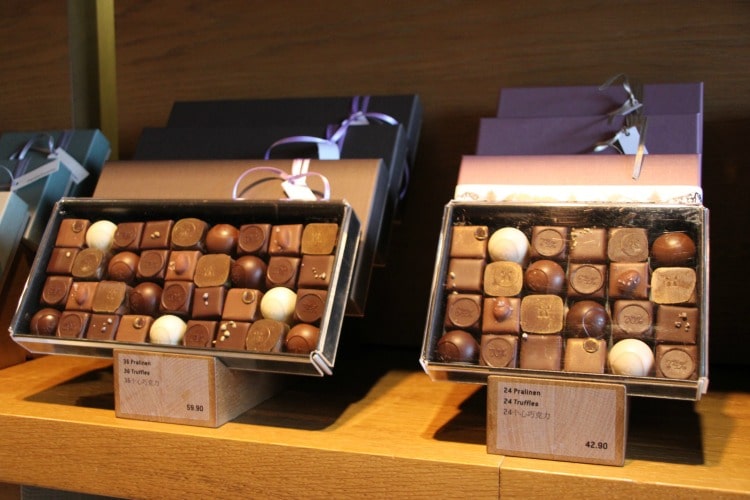
Swiss Delicacies
But watches are not the only thing that comes to mind when thinking of Switzerland. As we all know, there is chocolate and then, there is Swiss chocolate. At Max Chocolatier in Lucerne, artisan chocolate, which is meant to be savored, is hand-made. In addition to basic varieties like milk, dark, hazelnut, caramel, etc. there are also more exotic types with ingredients such as pumpkin, chili, or even Tasmanian pepper. One truffle takes four days to make according to store manager Daniela Silva and while not inexpensive, each bite delivers a rich, intense taste, so a small (or big) box is well worth the money! If you can refrain from eating it all, you can keep your treats in a chocodor. “The best place to store chocolate is actually in a wine cellar ideally at around 19°C, dry and dark”, explained Silva. “This handmade wooden treasure chest replicates those conditions.” For 599CHF ($595), however, you could buy many more of those chocolate truffles.
Another delicacy, available only in the cold months between October and March, are Heissi Marroni (hot chestnuts) which are sold at little outdoor stalls along the riverfront and in the Old Town. In the frigid winter, the steaming snack warms both inside and outside just like the Chäs Chüchli, little cheese tartlets found on hot plates outside some bakeries in Lucerne.
The local cuisine is hearty and often served in a rustic ambiance in the many traditional guesthouses of Lucerne, like the family-run Wirtshaus Galliker Luzern which has been open for over 160 years, or the Zunfthausrestaurant Pfistern, the town’s only surviving guild house dating back to 1578. It also has an eye-catching fresco and is one of around 200 painted houses in Lucerne.
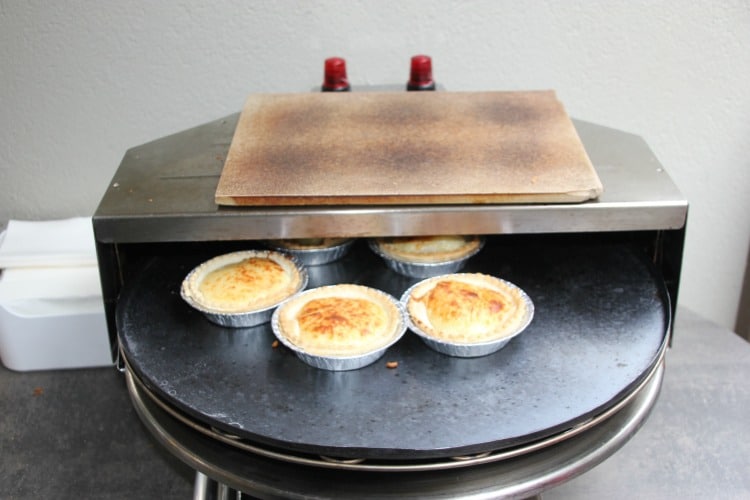
A Lion and a Legend
A short walk from the center of town lies what might arguably be the most famous lion in the world. An animal one would not expect to find in this part of the world, the story behind the titular rock carving is a tragic one. On August 10, 1792, some 1,000 Swiss Guards in Paris, seeking to protect the life of King Louis XVI from revolutionaries, paid the ultimate price for their unconditional loyalty.
Officer Karl Pfyffer, who was on leave at his home in Lucerne that fateful day, never forgot the loss of his comrades-in-arms. He raised funds for the powerful memorial, once called by Mark Twain “the most mournful and moving piece of stone in the world”, which pays homage to the selfless heroes of the Swiss Guard.
Less historical fact and more local fiction is the legend of the local mountain. From time immemorial, people believed that a dragon with healing powers and spirits inhabited the rugged cliffs high above Lucerne. It was also said that the ancient Lake Pilatus harbored the restless soul of Roman Prefect Pontius Pilate. Because of these myths ascents to Mount Pilatus were forbidden for a long time. Cursed be they, it was thought, who disturb the forces on the mountain.
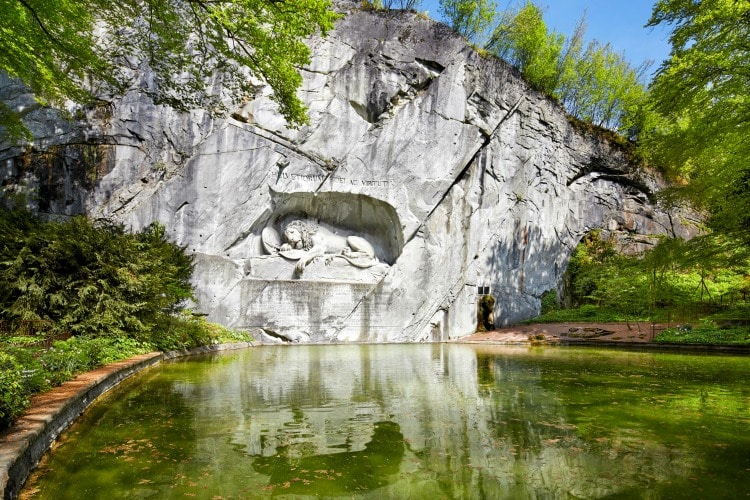
Today’s Pilatus
Today, there are two convenient ways to reach the top of Pilatus. The first, and more spectacular (May to November), is traveling by train or boat from Lucerne to Alpnachstad and then taking the world’s steepest cogwheel railway. When engineer Eduard Locher proposed building a railway on Mount Pilatus in the 19th century, many thought he was crazy. But in 1889, the 15,151 ft long track opened with a gradient of 48%. Since its opening nothing has changed of the ingenious design of two horizontally rotating cogwheels which made it possible to move a train forward at such a steep incline.
The second option of visiting Pilatus (all year round) is by twelve-minute bus ride from Lucerne central station to Kriens station where gondolas whisk visitors upwards to Fräkmüntegg, the largest rope park in central Switzerland complete with tree tents, toboggan runs, hiking trails, and scenic grilling spots. In winter, locals enjoy fast-paced sledding (wooden sleds are available for hire) and winter hiking trails.
At Fräkmüntegg travelers change from the gondola to the cable car and continue for another 3.5 minutes to the top, Pilatus Kulm (6995 ft). But despite the vast sports entertainment options, the hotels, and the restaurants and souvenir stores, most travelers come up here and to the surrounding peaks for the incredible views of Lake Lucerne and to enjoy the clear mountain air, just like Queen Victoria did.
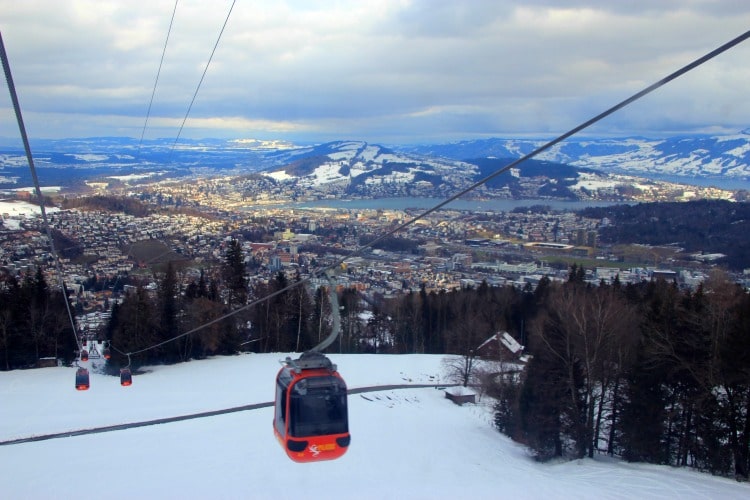
The country code for Switzerland is 41.
Where to Stay:
Hotel Beau Séjour – Located on Lake Lucerne with unobstructed views of the water and Mt Pilatus in the distance, this small hotel charms with an eclectic mix of old chandeliers and modern artwork on the walls. All 28 rooms are traditionally furnished, some have private balconies. Haldenstrasse 53, Lucerne, +41 41 410 16 81; www.beausejourlucerne.ch
The Barabas – Switzerland’s first jailhouse hotel is a budget-friendly accommodation option. The name is derived from a former inmate whose wall painting can still be seen in one of the rooms. Choose from dormitories, singles, doubles and family rooms and get locked up in one of the 60 converted cells. 16 & 18 Löwengraben, Lucerne, +41 41 417 01 99; www.barabas-Lucerne.ch/homeen
Where to Eat:
Wirtshaus Taube – This restaurant is the right place to go for hearty, traditional Swiss food. Dishes like the signature meatloaf are cooked and prepared according to old recipes and served in a rustic ambiance complete with sturdy wooden furniture. Burgerstrasse 3, Lucerne, +41 41 210 07 47; www.taube-Lucerne.ch/de
Nozomi – Since October 2018, Japanese cuisine has reached new heights in Lucerne. Fresh ingredients and creative dishes will whisk you away to Tokyo, Kyoto or Osaka. Perfect for a light lunch stop. Löwengraben 18, Lucerne, +41 41 417 01 98; www.nozomi-Lucerne.ch
Zunfthausrestaurant Pfistern – The traditional house dates back to 1578 and is located at the heart of the vibrant old town of Lucerne. It offers a pleasant symbiosis between traditional fare and scenic views of the Chapel Bridge. Kornmarkt 4, Lucerne, +41 41 410 36 50; www.restaurant-pfistern.ch/en
What to See & Do:
Chapel Bridge and Water Tower – Lucerne is divided by the River Reuss into an Old Town and a New Town; connecting the two is the world’s oldest covered wooden bridge, the Chapel Bridge, from 1332. The painted panels under its roof, added in the 17th century, portray scenes of Swiss and local history. Stroll on the Kapellbrücke which leads to the actual landmark of Lucerne, the octagonal Water Tower.
Lion memorial – The “Dying Lion of Lucerne” commemorates the heroism of Swiss soldiers who died in 1792 during the French Revolution, when revolutionaries stormed the Tuileries Palace in Paris. The monument was carved in a section of a natural cliff in 1820/21.
Mt Pilatus – Make your way up Lucerne’s local mountain, Pilatus, to shout from its snow-covered top. Ride on the world’s steepest cogwheel railway from Alpnachstad (May-Nov) or, alternatively, take a 15-minute bus ride to Kriens for transport on the panorama gondolas, followed by the aerial cableway “Dragon Ride”. www.pilatus.ch
Museums – Lucerne boasts an enviable selection of museums from the Museum of Art (www.kunstmuseumLucerne.ch/en) focusing on contemporary pieces, to the Rosengart collection (www.rosengart.ch) which shows Classic Modernists, Pablo Picasso, Paul Klee and other artists of the 19th and 20th century. The Swiss Museum of Transport (www.verkehrshaus.ch) covers over 3,000 items illustrating mobility on road, rail, water, air and space.

